In 1504, a copper globe was built somewhere in Europe. It stood only 4.4 inches in diameter and 13.6 inches in circumference, so it was nothing terribly overwhelming. Tiny ships and monsters adorned its seas—also commonplace at the time. But there was a small inscription, near the eastern coast of Asia, that made this particular globe one of a kind: it became the only documented ancient map to quietly go on record saying, Hic sunt dracones. Here be dragons.
Like a siren, the promise and danger of that single phrase called out to Western storytellers. Yet the dragons found on that globe, and the dragons found in literature today, are enormously different creatures. We should know: we’re the ones who re-wrote this mythical beast time and again. So just where be Western dragons at the beginning of their story? And how did they grow into the icons we know now?
Just a quick note: as the title indicates, this article will only look at the Western literary and fantasy traditions. There is, of course, a very long and rich history of dragons running through the mythos and literature of Eastern cultures, as well—but that is a discussion saved for another day.
Origins in Mythology
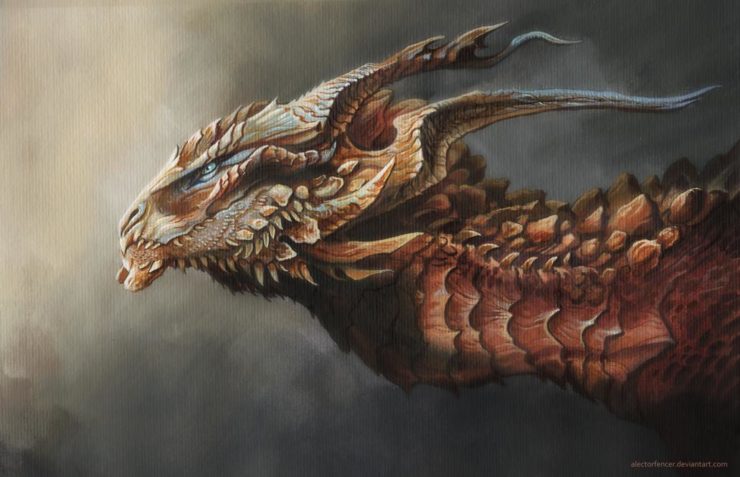
The origin of the dragon is such a mystery, even the exact etymology of its name is disputed. But you can mostly trace the meaning of dragon back to “serpent” (as with drakon in Ancient Greek and draco in Latin, for instance). If you dig deeper, its root derk- (or drk-) is the equivalent of “to see” in Ancient Greek—suggesting that drk-on also indicates “seeing one,” or “I see.”
Ironically, this power of sight was a one-way street: no one in the Western world could agree on what they saw of the dragon. As such, the earliest descriptions of them were fabulously inconsistent. Generally, dragons were titanic and powerful—but that was about where the common ground ended. Some accounts said that dragons were poisonous; others argued that they breathed fire; still others insisted that they were winged. In fact, if there was only one constant in ancient Western myths, it was this glaring certainty: dragons were stone-cold evil.
This speciest character assassination spanned the continent of Europe. In Greece, dragons were either monstrous beasts that stood in place to thwart protagonists from their heroic destinies (think Jason snatching the Golden Fleece from a dragon’s jaws), or public enemies to be overcome by gods and goddesses. Typhon, the father of all monsters, is defeated by Zeus; Python the serpent felled by Apollo; and Ladon, son of Typhon, dispatched by Heracles.
If you travel farther north, you’ll encounter the dragon Níðhöggr gnawing at the roots of Yggsdragil, the world tree of Norse mythology. To the south, the dragon-goddess Tiamat in Babylon is a symbol of the chaos of primordial creation: a “maelstrom of dark, roiling seawater” whose very death allows for the world to be born. But the most damning case against dragons comes from the Bible itself: in the Book of Revelation, Satan is said to descend upon the masses as (you guessed it) a great red dragon.
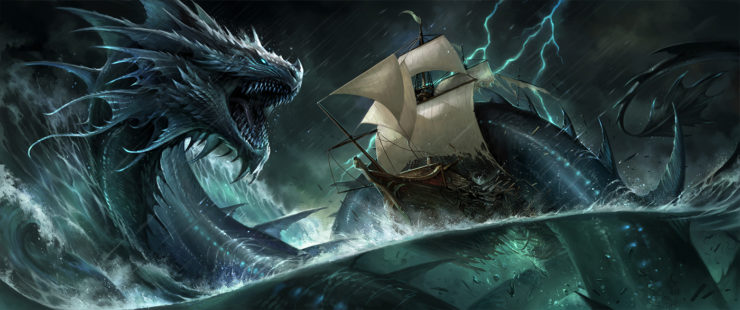
Such allegations would surely make any upstanding creature reel, but perhaps the last nail in the coffin was delivered by the earliest Latin bestiaries. Far from quelling society’s collective fears, they gaily fanned the flames. According to these works, dragons sat at the pinnacle of the zoological chain, and were incredibly wicked, shockingly vile… and very real to boot. Isidore of Seville wrote in Etymologiae:
The dragon is the largest of all the snakes, or of all the animals on earth. The Greeks call it Δράκων, whence the term is borrowed into Latin so that we say draco. It is often drawn out of caves and soars aloft, and disturbs the air. Even the elephant with his huge body is not safe from the dragon, for it lurks around the paths along which the elephants are accustomed to walk, and wraps around their legs in coils and kills them by suffocating them.
Then there was Hugh of Fouilloy, author of the famous Aviarium, who declared:
The dragon, the greatest of all serpents, is the devil, the king of all evil. As it deals death with its poisonous breath and blow of its tail, so the devil destroys men’s souls by thought, word, and deed.
If it was fake news, it was extremely convincing fake news, or so the people at the time probably thought. Eventually, the God-fearing public was tipped off that the dragon was really a mythical creature, not an actual, living, breathing monster come to Earth straight from Hell. But by that point the damage was done, and the battle lines were irrevocably drawn for millennia to come.
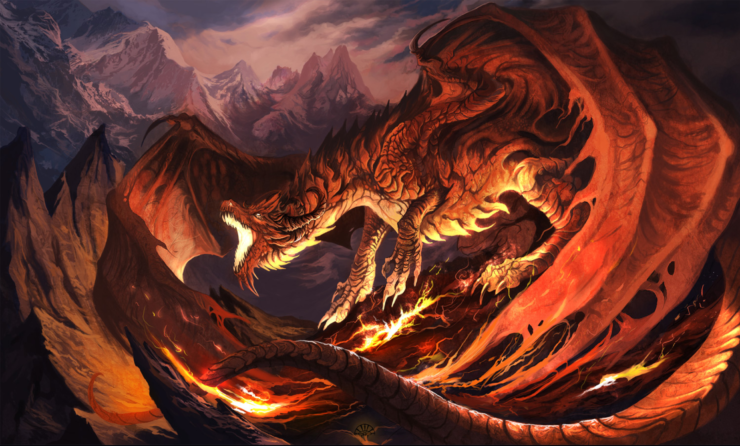
A Who’s Who of Major Dragons From This Era:
- Jörmungandr—The Midgard Serpent, or World Serpent, from Norse mythology. The arch-enemy of Thor, God of Thunder.
- Typhon—Commonly called the “father of all monsters” in Greek mythology. Had a hundred dragon heads sprouting from his shoulders, which must’ve been inconvenient in social situations.
- Ladon—The dragon who guarded the golden apples in the Garden of the Hesperides. Defeated by Hercules.
- Tiamat—The primordial dragon-goddess of the cosmos in Babylonian legend. Her death enables the Earth’s creation.
The Middle Ages to the Renaissance (1200 – 1600)
Due to the dragon’s reputation for swallowing villagers whole… and possibly breathing fire… and felling ancient world trees… and generally serving chaos and embodying evil, medieval folks were perhaps unsurprisingly keener on writing books titled How to Kill a Dragon than How to Train Your Dragon. In short, the dragon became typecast as the villain—one of the mightiest opponents that mankind could conceivably conquer.
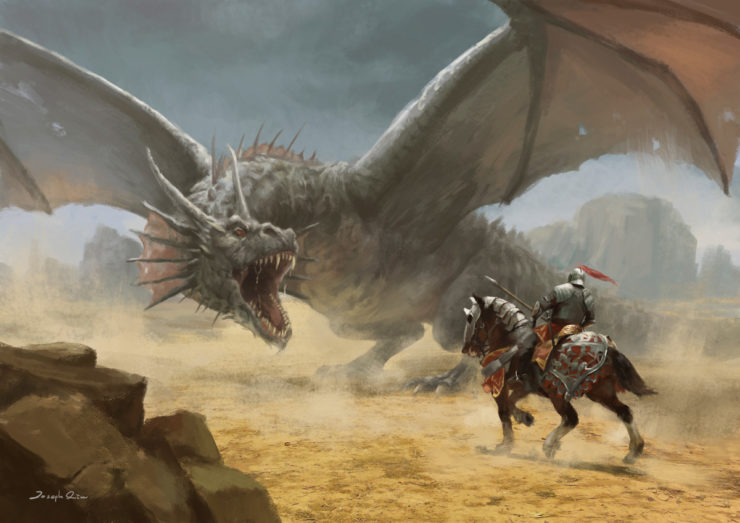
Errour from Edmund Spenser’s The Faerie Queen, Goji from medieval France, the Lambton Wyrm: such was the tally of dragons who fell in medieval and early modern Europe. But most dragons were nameless, footnotes in the ballads that were sung of brave men’s triumphs. In the 14th century’s Tale of Sir Eglamour of Artois, the dragon is Sir Eglamour’s ultimate—and most challenging—test. Sir Torrent of Portyngale ups this quota—Torrent gets to kill two dragons. Then you’ve got the dragons in Saint George and the Dragon and Tristan and Isolde, who meet identical grisly fates. Even the celebrated Knights of the Round Table get in on the action: in Thomas Malory’s Le Morte d’Arthur, Launcelot does epic battle with a massive, fire-breathing dragon in a tomb.
Each tale illuminated a certain pattern. The hero wins. The horse maybe dies. The dragon definitely dies.
This would be the template for a long time. And since one can’t kill this many a dragon without creating a few tropes, we see the fortification of several related motifs that soon would take flight in the public imagination: the maiden in need of rescue, the chivalric quest and climactic dragon-fight, and the castle.
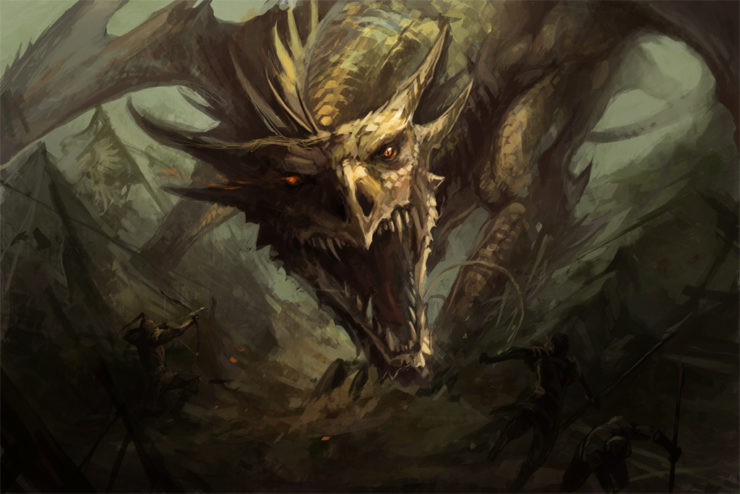
But a plot twist does transpire. The Middle Ages, an epoch that was basically a continual continent-wide massacre of dragons in western literature, would curiously give us two of the greatest dragons of all time. Today, Fáfnir from the Völsunga Saga and the unnamed dragon from Beowulf are central to draconic lore—not least because of the deep impression they made on the future grandmaster of fantasy. Said J.R.R. Tolkien in the 1938 lecture “On Fairy-Stories”:
Dragons, real dragons, essential to both the machinery and the ideas of a poem or tale, are actually rare. In northern literature, there are only two that are significant. If we omit from consideration the vast and vague Encircler of the World, Miðgarðsormr, the doom of the great gods and no matter for heroes, we have but the dragon of the Völsungs, Fáfnir, and Beowulf’s bane.
Buy the Book
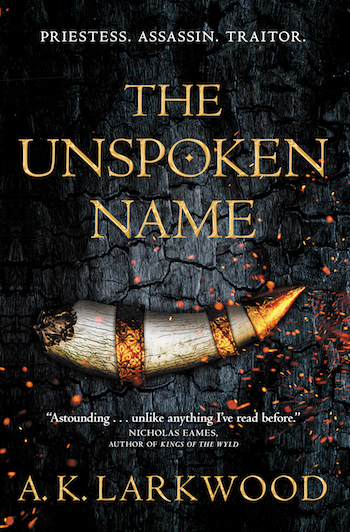

The Unspoken Name
The two dragons would cast long shadows for centuries. Both set the benchmark for a dragon’s ferocity, might, and potential for destruction. Both perpetuated the tropes most closely entwined with the dragon, including fire and the greed for gold. And both forged the construct of the dragon-slayer, for both were slain by mortals: Sigurd and Beowulf, respectively.
Yet this wasn’t even the hardest trial at hand. In this age and all coming ages, the dragon still faced an even greater enemy: its own biblical ghost. To the people of the Middle Ages, it was Satan, plain and simple—and it deserved to be killed every time.
A Who’s Who of Major Dragons From This Era:
- Fáfnir—A man who became a great dragon because of his greed. Defeated by Sigurd.
- The Dragon from Beowulf—A terrible unnamed dragon from the Anglo-Saxon epic. The dragon-fight ends with the deaths of both Beowulf and the dragon.
- The Dragon from George and the Dragon—An unnamed dragon that was only appeased by human sacrifices. Dramatically defeated by St. George.
- Errour—A serpent-monster from Edmund Spenser’s The Faerie Queen. Defeated by the Redcrosse Knight.
The Shadow of Tolkien (Early 1900s)
Between 1700 and 1900, a number of things come to pass: The Age of Enlightenment dawns. The United States of America is created. The Ottoman Empire begins to fall. A thousand French cartoonists call Napoleon short. The first modern novel is written. Fantasy starts its rise as a genre. And dragons are pretty much nowhere to be seen in literature, so much so that May Dacre exclaims in Benjamin Disraeli’s 1831 The Young Duke, “The age of chivalry is past. Bores have succeeded to dragons.”
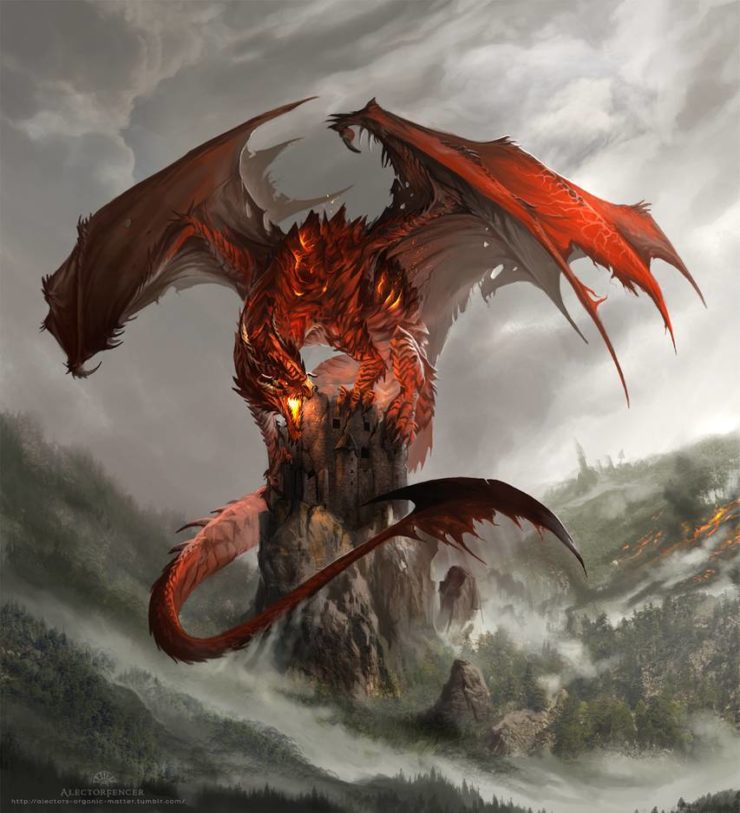
Why did writers in these centuries mostly, excuse the pun, wing it? According to critic Ruth Berman:
During the nineteenth century, fantasy became a genre, but the absence of dragons among the wealth of ghosts, witches, devils, mer-folk, fairies, etc., is striking. Monsters in general were rare, but dragons were much rarer. […] The reluctance to use dragons was probably a result of the too rigid identification of the dragon with the dragon of the Book of Revelations, that is, Satan.
It would take until the turn of the twentieth century for the dragon to find storytellers who dared to reach out and court whispers of blasphemy by resurrecting them: children’s authors, and (spoiler alert!) J.R.R. Tolkien. The former group of writers—always up to satirize and play with convention—can be credited with providing the first literary sandbox for playing with the idea of dragons. Case in point: Kenneth Grahame’s 1898 The Reluctant Dragon and E. Nesbit’s 1899 The Book of Dragons were among the earliest books to show benign, comic, and “good” dragons.
In stark contrast stood the dragons conjured by Tolkien, whose childhood dreams had always sought out the titanic, formidable dragons of old. He once said:
I desired dragons with a profound desire. Of course, I in my timid body did not wish to have them in the neighborhood. But the world that contained even the imagination of Fáfnir was richer and more beautiful, at whatever cost of peril.
The Lord of the Rings and The Silmarillion were the culmination of Tolkien’s soaring vision. The dragons of Middle-earth were majestic, fire-breathing, and terrifying, bearing a greater resemblance to Tolkien’s other terrible monsters, such as the blazing Balrog of Morgoth, than to the chummy dragons of children’s books. The DNA they share with Fáfnir and Beowulf’s dragon is unmistakable. Like their ancestors, Tolkien’s dragons possess tremendous antiquity. Like their ancestors, they are mighty and cunning, and they covet gold above all else. Even certain episodes from The Lord of the Rings seem to mirror scenes from the Völsunga Saga and Beowulf (Bilbo’s theft of a golden cup from Smaug in The Hobbit is clearly similar to the single cup that’s stolen from the dragon in Beowulf, for instance).
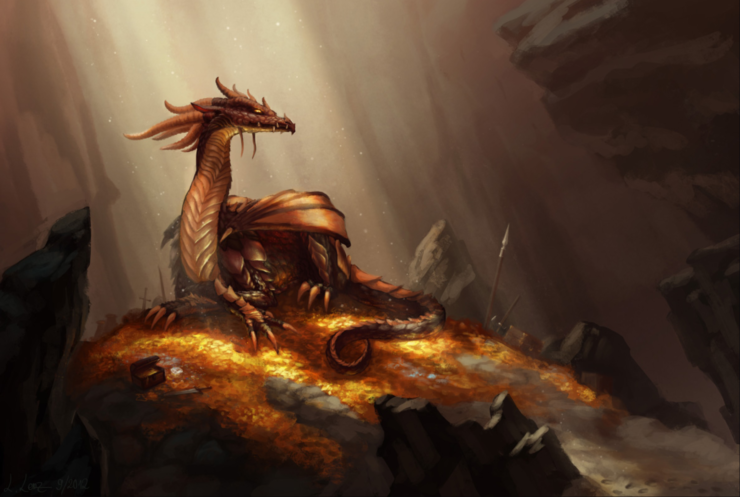
But Tolkien undertook a mission more complicated than just a simple revival of older traditions. Before him, dragons were evil and dangerous. With Tolkien, well, they were still evil and dangerous. But he also attempted to give his dragons “bestial life and thought of [their] own” (as he’d put it in his 1936 lecture “Beowulf: The Monsters and the Critics”). Tolkien saw Fáfnir’s early power of speech and raised it a satisfying sense of self, finally imparting this ancient species with the gift of a fully-formed mind and tongue. And so it’s a bit ironic that so much of the fantasy genre is made in Tolkien’s image—except for dragons. As that same lecture on Beowulf made clear, the father of fantasy had always considered draco “a personification of malice, greed, destruction, and of the undiscriminating cruelty of fortune that distinguishes not good or bad.”
In other words, the dragon’s redemption tale still couldn’t begin just yet: it would need to wait another couple of decades for the right authors to come along.
A Who’s Who of Major Dragons From This Era:
- Ancalagon the Black—The greatest of all Middle-earth’s winged dragons, according to The Silmarillion. His fiery death ended the First Age.
- Glaurung—The Father of Dragons in Middle-earth. Wingless, poisonous, and terrifying.
- Smaug the Golden—The last of Middle-Earth’s “great” dragons. Defeated by Bard the Bowman in the Third Age, as recounted in The Hobbit.
- The Dragon, from The Reluctant Dragon—A scholarly dragon who especially loves poetry, and is befriended by a young boy.
Women and the Rehabilitation of the Dragon (1950 – 1990)
So by the time we enter the 1950s, nothing’s changed too much. That swath of space on the map branded “Here Be Dragons” is still, for the most part, rather bleak. A few books appeared to fight the tide: for instance, 1948’s My Father’s Dragon, by Ruth Stiles Gannett, joins children’s books like The Book of Dragons and The Reluctant Dragon in depicting a “good” dragon. But we don’t see anything really moving the needle until two SFF authors, Anne McCaffrey and Ursula K. Le Guin, become ascendant in the 1960s.
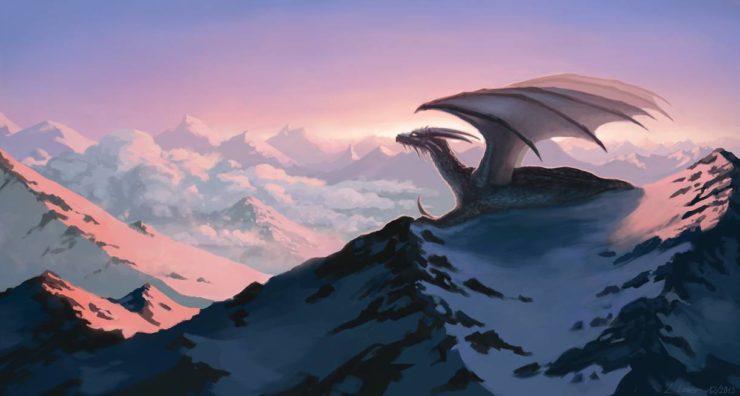
First, McCaffrey, the creator of Pern, stepped up to the plate—becoming perhaps the first Western adult fiction writer to definitively show the world that a dragon didn’t need to be evil just because it was a dragon. Her slim Weyr Search, first published in Analog in 1967, boasted feudal rulers, time travel, stolen birthrights. Most importantly, it featured telepathic dragon companions—capable of forming deep bonds with their dragon-riders (yet another mind-melting concept, at the time).
Delivering a one-two punch to the genre’s conventions, Ursula Le Guin published A Wizard of Earthsea soon afterward in 1968. Her importance in modern fantasy is today impossible to quantify. In January 2018, John Scalzi wrote in the Los Angeles Times that losing Le Guin was “like losing one of the great sequoias.” In another of the countless tributes made upon her death, Arnab Chakraborty asked, “What was her secret?”
It was merely this: you take a dragon (one of Le Guin’s most brilliant re-inventions). A dragon is that hoary old standard of fantasy, and this poor creature is now waiting on some clifftop, tired and exhausted at having been cast in so many tales and parables down the ages. He wants some rest, some well deserved shut-eye. But soon comes hobbling down the road an old woman with a twinkle in her eye, and she proceeds to sit down beside him. The dragon senses her presence, braces for yet another request to star in a quest, a razing of towns, a romance. But this woman merely wants to speak to someone at the end of her long journey uphill. Just that. And the dragon is, for once, asked about his views on the world. Just a conversation, really.
And perhaps that was exactly the route that Le Guin took to create four of the most magnificent dragons that we’ll ever encounter. To this day, Yevaud, Orm Embar, Kalessin, and Orm Irian are towering examples of all that dragons can be. As Hugo-nominated fantasy writer Max Gladstone said over at The Ranting Dragon:
Le Guin’s dragons set the gold standard. Ancient, wise, capricious, beautiful, mighty, and sometimes sad, she salts Tolkien’s profoundly Western dragons—for all his majesty, Smaug the Terrible is a clear descendant of the “St. George” and the species of dragon—with elements of the Chinese demigod. […] While Le Guin’s fingerprints on the genre are subtler than Tolkien’s, I don’t think we would have the modern fantasy dragon—subtle, cunning, alien, wrathful and compassionate all at once—without her work. Seraphina and Temeraire owe a great deal to Orm Embar.
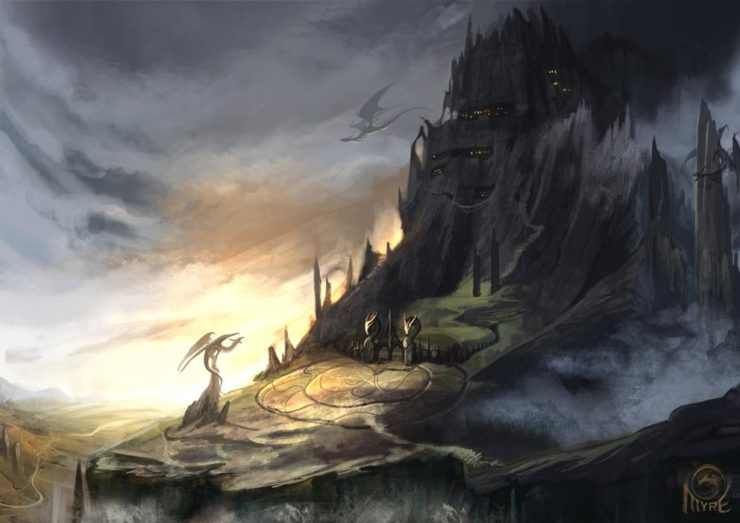
Extraordinarily, Le Guin’s and McCaffrey’s dragons were moreover so shockingly distinct that they created two strapping draconic lineages in fantasy, going forward. As John Lennard observes in Of Modern Dragons, Pernese dragons “[reverse] all the Beowulfian tropes while preserving the winged and fiery reptilian form.” In stark contrast, Earthsea’s dragons retain shades of Fáfnir and Smaug, most markedly in their marvelous linguistic faculties. The incongruities run deeper: Pernese dragons are decidedly moral and “good.” Earthsea’s dragons are neither good nor evil, but rather unpredictable, unmoved by the squabbles of mere mortals, and frighteningly unknowable. Pernese dragons are relatively young, not being around when Pern was created. Earthsea’s dragons are as ancient as Earthsea itself.
Pernese dragons, in other words, are tamed comrades. Earthsea’s dragons are demi-gods.
But it’s the one commonality they did share that really matters. Little did McCaffrey or Le Guin realize the extent of the draconic activity that their dragons would trigger over the next few decades (including such amazing examples as Michael Ende’s The Neverending Story in 1979, Robert Munsch’s The Paper Bag Princess in 1980, Terry Pratchett’s gleefully irreverent Draco Nobilis and Draco Vulgaris species in Discworld in the 1980s, and Tracy Hickman and Margaret Weis’ Dragonlance series in 1984! And that’s just to name a few). If not for McCaffrey and Le Guin, today’s awesome and diverse dragons might be DOA (Dead On Arrival, or perhaps Dragons Overtly Absent). And our world would be that much poorer for it.
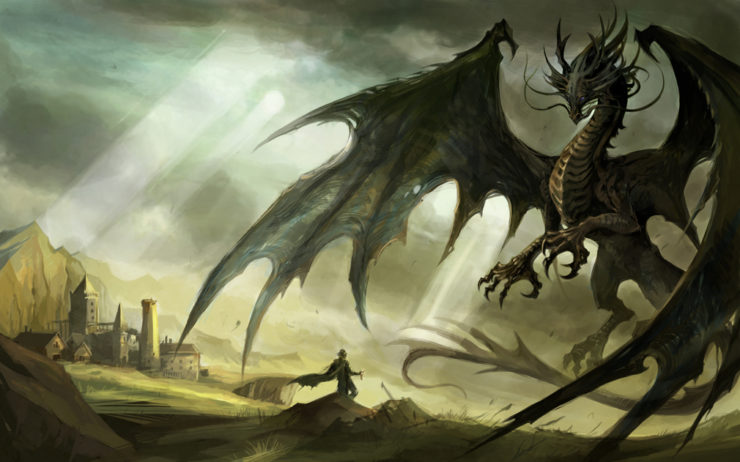
Looking back now, the dragon’s redemption tale might seem inevitable, but it really wasn’t a sure thing, by any means. That uncharted territory on the map marked “Here Be Dragons” was more powerfully emblematic than anyone could’ve guessed. After generations of writers had either vilified or outright ignored that spot of land, two women finally ventured forth into it and made the fateful decision to choose the road not taken, thank you very much—toppling millennia of unexamined preconceptions and prejudice against dragons in the process.
A Who’s Who of Major Dragons From This Era:
- Yevaud—The Dragon of Pendor in the world of Earthsea. First appears in the 1964 short story “The Rule of Names.”
- Orm Irian—The dragon-daughter of Kalessin the Eldest who can turn into a woman at will. First appears in Earthsea’s The Other Wind.
- Ramoth—The golden dragon-queen during the Eight Interval and Ninth Pass in Dragonriders of Pern. Her rider was Lessa.
- The Jabberwock—The eponymous dragon of Lewis Carroll’s “Jabberwocky” nonsense poem, and winner (or perhaps loser) of the best dragon name…and there are certainly a lot to choose from.
- Falkor—A luckdragon who plays a major role in Michael Ende’s 1979 The Neverending Story. Befriends Atreyu, a boy warrior.
- Eustace Scrubb—A young boy (“There was a boy called Eustace Clarence Scrubb, and he almost deserved it”) from The Voyage of the Dawn Treader. Temporarily turned into a dragon through his own unchecked greed.
Here Be Dragons (1990s – Present)
You’re probably already well aware of the dragon’s rock star status in popular culture today. Unless you’ve been sequestered underneath an extremely large rock for the last couple of decades, it’s tough not to notice that dragons are pretty much everywhere: from the silver screen (How to Train Your Dragon, Pete’s Dragon, Mulan, and, of course, Peter Jackson’s three Hobbit movies, among others) and television (HBO’s Game of Thrones) to games (Spyro, Warcraft, Final Fantasy, Skyrim).
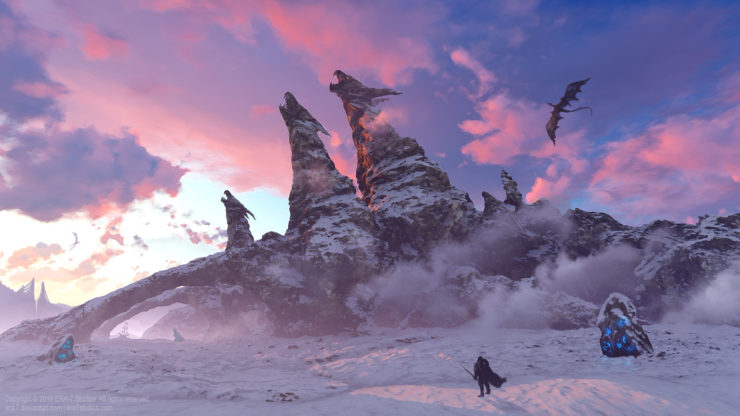
And in books? We can’t seem to get enough. Temeraire, Drogon, Saphira: today’s crop of complex, multi-dimensional dragons are basically minor celebrities in fantasy and science fiction. In them we can still see echoes of the dragons that came before. (Temeraire, for instance, is probably a nearer descendant of Ramoth than that great and malicious beast of yesteryear, Fáfnir.) Yet this generation is also coming up with new ways to shape the great, ongoing draconic narrative. Epic fantasies such as Game of Thrones present dragons as wild beasts that can nevertheless be befriended and bonded with (at least by some), while other works such as Marie Brennan’s Lady Trent series and Elizabeth Peters’ Summer of the Dragon explore dragons from a naturalist’s perspective.
It admittedly took us millennia to move past ingrained superstition and begin to reconsider the role of the dragon in storytelling. And yet the joke’s on us: in the time that it took for us to start reshaping the dragon in Western literature, the dragon was busy reshaping the very terrain of our own imaginations. Critic David E. Jones argues that humans have always had an “instinct for dragons” (in fact, it’s the title of his book on the subject). And in an essay for Abe Books, author Beth Carswell writes:
It’s fascinating that humans have not only created the fictional, mythical creature of the dragon, but also repeatedly adhered to recurring archetypes around it—where there is a dragon, one can almost always expect to find any or all of the following: gnomes, dwarves, castles, knights, princesses, trolls, goblins or treasure. We have created not only a magnificent animal from thin air, but also entire landscapes to support its legend.
So where do dragons go now in Western literature? Given all the twists and turns that their story’s taken over the centuries, it might be impossible to predict. But this much at least should be certain: they’re not going to go away. Dragons have already come with us this far: looming large in our legends since antiquity, wheeling in the skies as European knights came and went, rising to new heights as fantasy really took flight in the last century—and they’ll hopefully stick around, soaring through our literary future, continuing to test our sheer capacity for wonder. There is, after all, that maxim that Le Guin relates in her introduction to Tales of Earthsea: “Nobody can explain a dragon.” Luckily for us, authors of every age have never stopped trying.

A Who’s Who of Major Dragons From This Era:
- Temeraire—A rare Chinese Celestial dragon born during the Napoleonic wars. Bonds with Captain William Laurence in Naomi Novak’s Temeraire series.
- Drogon—One of Daenerys Targaryen’s three dragons in George R.R. Martin’s A Song of Ice and Fire. Huge and black, with a wingspan of twenty feet as of A Dance with Dragons.
- Saphira—Eragon’s dragon from Christopher Paolini’s Inheritance Cycle. One of the last female dragons in Alagaësia.
- Toothless—Hiccup Horrendous Haddock III’s dragon in Cressida Cowell’s How to Train Your Dragon. Commonly mistaken for a Common or Garden dragon.
- Villentretenmerth—One of only two Golden dragons in the history of the world of The Witcher; able to assume many forms through polymorphism. In Common Speech, his name means Three Black Birds.
Originally published October 2019.
Yvonne Shiau is a writer who enjoys walking through mountains. She is currently based in South America.










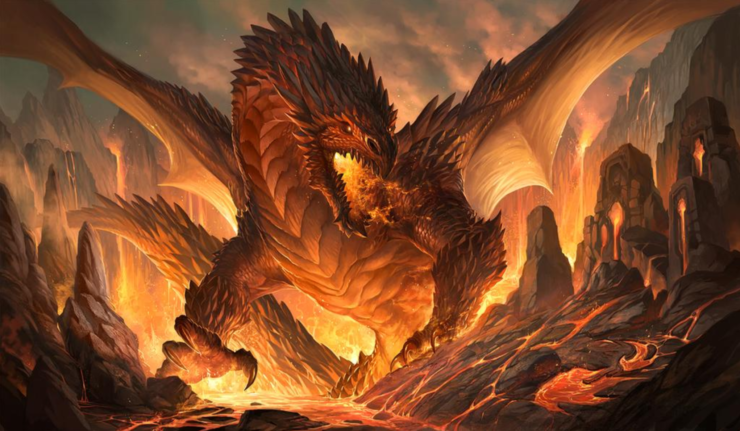
Thank you so much for this wonderful article!
What of the symbol of Wales (Cymru), the glorious red dragon? She (ddraig coch is a feminine construction) is very positive to the dwellers in Wales. And probably comes from the tale of Merlin, Vortigern and the red and white dragons fighting beneath where Vortigern wishes to build his castle.
This was a great article, very well done! One thing I will chime in about with the modern era of dragons is that as gaming becomes a much bigger part of popular culture and a storytelling medium in its own right, having dragons involved doesn’t just offer a chance to engage in these longstanding tropes, but also provides some tempting opportunities for gameplay. After all, if you need a powerful enemy to serve as a challenge for the player to overcome, or provide a climatic battle for an end-game raid or dungeon, what better creature to use than a dragon?